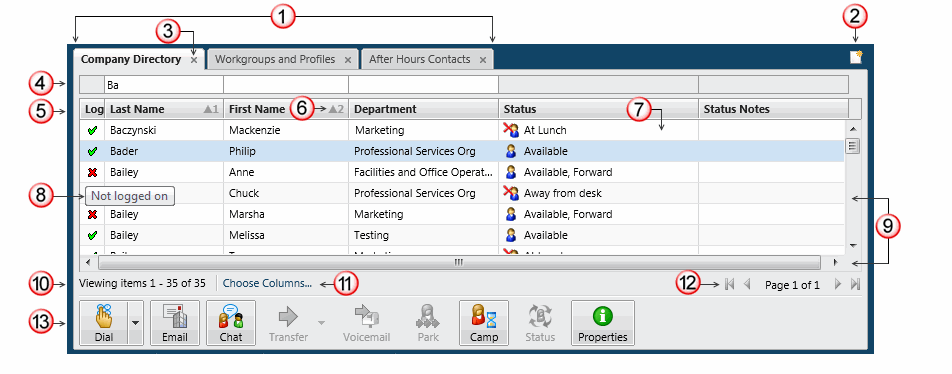|
Interaction Client Web Edition Help |
Requirements: The View General Directories Access Control right determines which General Directories you can display. The Directory Administrator Security right enables you to edit all public directories. You need the View Directory Status Columns Access Control right to all or selected Status columns to enable you to add Status columns to a directory view. The View Directory Status Columns Access Control right also determines whether you can view a user’s status in the directory shortcut menu.
Interaction Client Directories contain contact information such as names, telephone numbers and extension, email address. They can also display Interaction Client status information. You can use the information in these directories to make and manage interactions. You can configure which available directory views appear in Interaction Client. For more information, see Working with the Company Directory and Working with Other Directories.
Interaction Client preserves all your directory settings when you log on again to the same IC server from the same web browser. Directory settings include the last selected tab, sort order, selected columns, column widths and order, and filters.
Each directory contains a list of names. You can:
Call the default number associated with a contact by double-clicking a name.
Click a phone number hyperlink to dial a directory contact.
View the contact’s properties such as addresses and additional phone numbers.
Edit a directory entry if you have the appropriate permission as assigned to you in Interaction Administrator.
View a status summary for all users.
You control the appearance of your directories. You can:
Add or remove columns from a directory view.
Note: Your CIC administrator must grant you the View Status Columns access control right to all or selected Status columns to enable you to add Status columns to a directory view.
This diagram shows multiple directory views in Interaction Client. Each directory view appears on a separate tab.

1 |
The three tabs represent three different directories. Each is labeled with the name of the directory. |
|
2 |
Click the New Tab button to display a list of available directories. Select a directory to display it in Interaction Client. For more information, see Add or Close Views. |
|
3 |
Select a directory tab and click the Close button to stop displaying the directory view. It is not removed and can be added back to the Interaction Client interface. |
|
4 |
Use the search fields to locate a specific directory entry or group of entries. For more information, see Search a Directory. |
|
5 |
You can drag and drop a column heading to move a column to a different position. For more information, see Customize Columns. |
|
6 |
Triangles indicate whether the contents of a column are sorted in ascending or descending order. If the contents of a directory are sorted by more than one column, a number indicates the sort order. For more information, see Sort a Directory. |
|
7 |
Use the default Status or the Status Summary column to determine if a contact is available to take a call. Several other status columns are available, including Status Notes and Time in Status. For more information, see Customize Columns. |
|
8 |
Some columns enable you to display a content tooltip for more information than can appear in a narrow column. A tooltip can also provide additional information. Logged On tooltip: In this example, the tooltip for the Logged On column explains the icon. When a user is logged on the name of the station where the user is logged on. The station name appears if that user is logged on to the same IC server as you. If the selected user is logged on to a different IC server, the tooltip shows the name of the IC server. |
|
9 |
Horizontal and Vertical scroll bars |
A horizontal scroll bar appears if the total width of the columns exceeds the space available in the browser window. A vertical scroll bar appears if all the entries in a single view cannot be displayed in the space available. |
10 |
View description |
This section describes the contents of the current view and lists the total number of entries in the directory or search results. In this example, entries 1 through 15 appear in the current view and there are a total of 27 entries in these search results. |
11 |
Use the Choose Columns control to add or remove view columns from the current directory. |
|
12 |
A large directory or set of entries is displayed in a paged format. The First, Previous, Next, and Last Page controls enable you to navigate from one page to another in the directory. Note: By default, directories with more than 100 contacts appear in a paged format. Your CIC administrator determines how large a directory must be before it appears in a paged format and how many contacts appear on a single page. |
|
13 |
Use the Directory toolbar to manage your contacts and interactions with those contacts. For more information, see Using the Directory Toolbar. |
Related Topics